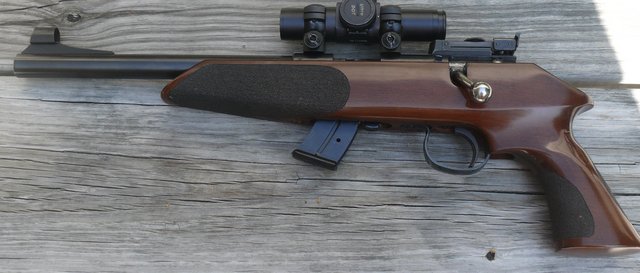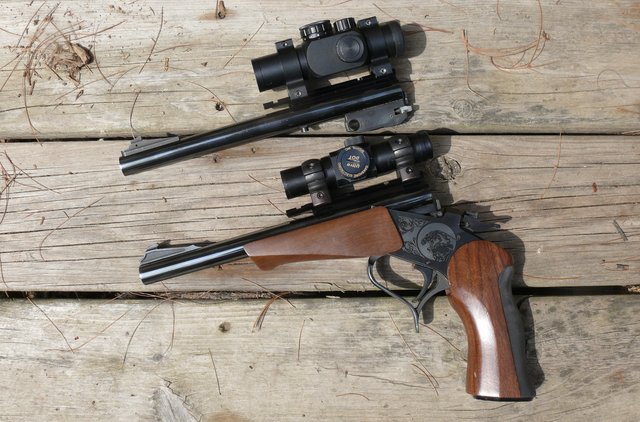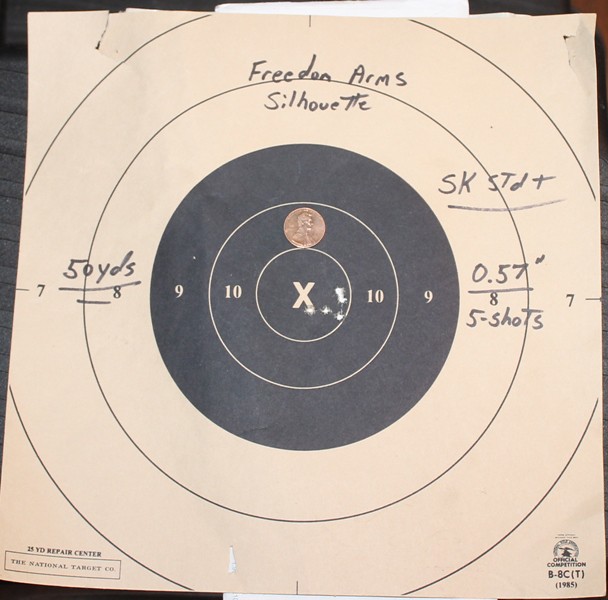Time for a fun experiment.
Howard Funk (hrfunk) is a name lots of us may recognize for his informative and entertaining videos on You Tube. One which grabbed me recently was “My Most Accurate .22 Pistol.”
Howard owns six .22 handguns, the same as I do, and he set out to have some fun by comparing their accuracy under some moderately controlled conditions. With my major matches mostly behind me until next fall, I had time to back off from my regular training schedule and enjoy Howard’s experiment with my own guns.
It didn’t hit me until I was preparing the guns for the range session that this possibly came down to a Ruger versus Smith & Wesson contest! The participants include four revolvers and two automatics. Revolvers first:
![Image]()
Bottom to top, these are a 6-1/2” Single Six, a 6” S&W 17-3, a 4” S&W 63, and a 6” S&W 617-6. That’s one each of S&W’s J, K and L frames. The 617 has a 10-round cylinder and the others are all 6-shooters. The 617 also differs from the others in that it has a fiber optic front sight. All have adjustable sights.
Next, the automatics:
![Image]()
The bottom gun is a 1983 vintage Ruger Mk II, which dates to the Mk II’s second year of production. The upper gun has been shown on this forum a few times; it’s a 22/45 Mk II which I bought new at my first Arizona gun show 20 years ago. Both guns have Volquartsen trigger kits installed, and both have fiber optic front sights substituted for the benefit of faster sight pickup in the steel plate matches I use these guns for.
My test protocol was similar to Howard’s, with a couple of notable differences. Howard correctly notes that .22s are well-known for having individual ammo preferences, but chasing down a gun’s favorite fodder would have expanded the experiment tremendously. To keep things simple, he chose Wolf Match Target, a premium ammo that generally performs well in a lot of guns. What I had on hand was the slightly pricier Wolf Match Extra, which performs exceptionally well in a couple of my custom-barrelled 10/22s. Prior to shooting, all guns had their chambers and bores thoroughly cleaned. I shot from a single sandbag rest on a concrete bench, and target distance was 11 yards. Where I went a step further than Howard was that I fired six rounds into a paper plate target for bore conditioning prior to shooting for the record, as we all know it often takes several rounds for a rimfire bore to acclimate to a given ammo’s lube or coating. This was worthwhile, as more than one gun threw its first shot or two several inches away from where the subsequent shots grouped. Following the 6 conditioning shots, I then shot two targets of six shots each.
A few disclaimers before I get into the results. Although I’m no stranger to revolvers, the grips on the Single Six and the classic M17 just did not work well with the combination of my hands and the sandbag rest. For those two, the heel of the grip seemed to extend below my hands and seated directly on the sandbag. With the other four guns, my 2-handed grip separated the heel of the guns from the sandbag. This may factor into the results, as I’ll describe later.
Next, the fiber optic front sight on the 617 and both Ruger automatics presented a less-defined sight picture than the crisp Patridge blades on the Single Six and the 6-shot Smiths. In particular, achieving a consistent alignment of the top of the front sight blade with the top of the rear sight notch seemed more difficult with the fiber optics. I have F/O sights on my competition (action pistol) guns, and I think there’s a tradeoff for speed of sight pickup versus precision.
Lastly, the three double-action revolvers were all fired in single-action mode. For the 617, with its 10-shot cylinder, there was no attempt to cherry-pick the best 6 chambers… 6 rounds were loaded sequentially, starting with whichever empty chamber my fingers found first.
Now the results! Targets were photographed and groups were measured center-to-center using On Target software. Looking at 2 targets per gun, I measured both the overall group size and then the size of the best 5 of 6 shots, as there was typically 1 flyer (some called, some not) per group.
6-shot group / best 5 of 6 shots
Ruger Mark II 1.96” / 1.50”
Ruger 22/45 1.31” / 0.58”
Ruger Single Six 1.50” / 1.16”
S&W 63 1.45” / 0.94”
S&W 17 2.79” / 1.67”
S&W 617 1.03” / 0.92”
These results had some surprises. The top shooters were the 617 revolver and the 22/45, both of which had good triggers, and in spite of both having fiber optic front sights. Biggest disappointment was the Model 17! This had a last-place showing in both overall group size and best 5 out of 6. I’m pretty sure this poor showing was related to my inability to get a good grip on the gun, and the possible hard contact between the butt of the grip and the sandbag, as noted above. As evidence, the group size is biased by the large vertical dispersion of my shots, which is nearly triple that of the horizontal. I think the 17 deserves another chance for the shooter to improve his grip! (Spoiler alert… stay tuned.)
The ”ringer” of the day was the J-frame Model 63, the 22/32 Kit Gun as S&W once called it. This gun has a delightful single action trigger and a very useful set of sights. The shortest barrel and sight radius of the 6 guns clearly did not put the gun at a disadvantage! Now if I could just get its double action trigger down under 10 pounds it could really be a fun gun.
Other observations: First, Howard is clearly a better shooter then I am! From a sandbag rest at just 11 yards I expected a number of groups under one inch, but only the 617 flirted with that number. Next, the automatics were way easier to shoot consistently, as the 5 shots after the first in each group were fired from trigger reset. The revolvers all required the hammer to be manually cocked, which meant the sight picture had to be re-established for every shot. Finally, human error is a constant companion in this sort of exercise so disregarding at least one bad shot per group is not unreasonable.
Are there any useful conclusions to be drawn from this exercise? That’s a solid nope. What I do know empirically from lots of rounds down range with each of these guns is that choosing one single flavor of ammo for all guns puts several of them – the S&W 17 in particular – at a disadvantage.
The targets:
![Image]()
![Image]()
![Image]()
![Image]()
![Image]()
![Image]()
My apologies for going Hemingway on you good folks and turning this into a real scroller. Bottom line is that it was a fun experiment, even if the goal of determining the most accurate of Smitty’s .22 handguns wasn’t achieved. That’s just a challenge for more experimentation, so… watch this space!
Howard Funk (hrfunk) is a name lots of us may recognize for his informative and entertaining videos on You Tube. One which grabbed me recently was “My Most Accurate .22 Pistol.”
It didn’t hit me until I was preparing the guns for the range session that this possibly came down to a Ruger versus Smith & Wesson contest! The participants include four revolvers and two automatics. Revolvers first:
Bottom to top, these are a 6-1/2” Single Six, a 6” S&W 17-3, a 4” S&W 63, and a 6” S&W 617-6. That’s one each of S&W’s J, K and L frames. The 617 has a 10-round cylinder and the others are all 6-shooters. The 617 also differs from the others in that it has a fiber optic front sight. All have adjustable sights.
Next, the automatics:
The bottom gun is a 1983 vintage Ruger Mk II, which dates to the Mk II’s second year of production. The upper gun has been shown on this forum a few times; it’s a 22/45 Mk II which I bought new at my first Arizona gun show 20 years ago. Both guns have Volquartsen trigger kits installed, and both have fiber optic front sights substituted for the benefit of faster sight pickup in the steel plate matches I use these guns for.
My test protocol was similar to Howard’s, with a couple of notable differences. Howard correctly notes that .22s are well-known for having individual ammo preferences, but chasing down a gun’s favorite fodder would have expanded the experiment tremendously. To keep things simple, he chose Wolf Match Target, a premium ammo that generally performs well in a lot of guns. What I had on hand was the slightly pricier Wolf Match Extra, which performs exceptionally well in a couple of my custom-barrelled 10/22s. Prior to shooting, all guns had their chambers and bores thoroughly cleaned. I shot from a single sandbag rest on a concrete bench, and target distance was 11 yards. Where I went a step further than Howard was that I fired six rounds into a paper plate target for bore conditioning prior to shooting for the record, as we all know it often takes several rounds for a rimfire bore to acclimate to a given ammo’s lube or coating. This was worthwhile, as more than one gun threw its first shot or two several inches away from where the subsequent shots grouped. Following the 6 conditioning shots, I then shot two targets of six shots each.
A few disclaimers before I get into the results. Although I’m no stranger to revolvers, the grips on the Single Six and the classic M17 just did not work well with the combination of my hands and the sandbag rest. For those two, the heel of the grip seemed to extend below my hands and seated directly on the sandbag. With the other four guns, my 2-handed grip separated the heel of the guns from the sandbag. This may factor into the results, as I’ll describe later.
Next, the fiber optic front sight on the 617 and both Ruger automatics presented a less-defined sight picture than the crisp Patridge blades on the Single Six and the 6-shot Smiths. In particular, achieving a consistent alignment of the top of the front sight blade with the top of the rear sight notch seemed more difficult with the fiber optics. I have F/O sights on my competition (action pistol) guns, and I think there’s a tradeoff for speed of sight pickup versus precision.
Lastly, the three double-action revolvers were all fired in single-action mode. For the 617, with its 10-shot cylinder, there was no attempt to cherry-pick the best 6 chambers… 6 rounds were loaded sequentially, starting with whichever empty chamber my fingers found first.
Now the results! Targets were photographed and groups were measured center-to-center using On Target software. Looking at 2 targets per gun, I measured both the overall group size and then the size of the best 5 of 6 shots, as there was typically 1 flyer (some called, some not) per group.
6-shot group / best 5 of 6 shots
Ruger Mark II 1.96” / 1.50”
Ruger 22/45 1.31” / 0.58”
Ruger Single Six 1.50” / 1.16”
S&W 63 1.45” / 0.94”
S&W 17 2.79” / 1.67”
S&W 617 1.03” / 0.92”
These results had some surprises. The top shooters were the 617 revolver and the 22/45, both of which had good triggers, and in spite of both having fiber optic front sights. Biggest disappointment was the Model 17! This had a last-place showing in both overall group size and best 5 out of 6. I’m pretty sure this poor showing was related to my inability to get a good grip on the gun, and the possible hard contact between the butt of the grip and the sandbag, as noted above. As evidence, the group size is biased by the large vertical dispersion of my shots, which is nearly triple that of the horizontal. I think the 17 deserves another chance for the shooter to improve his grip! (Spoiler alert… stay tuned.)
The ”ringer” of the day was the J-frame Model 63, the 22/32 Kit Gun as S&W once called it. This gun has a delightful single action trigger and a very useful set of sights. The shortest barrel and sight radius of the 6 guns clearly did not put the gun at a disadvantage! Now if I could just get its double action trigger down under 10 pounds it could really be a fun gun.
Other observations: First, Howard is clearly a better shooter then I am! From a sandbag rest at just 11 yards I expected a number of groups under one inch, but only the 617 flirted with that number. Next, the automatics were way easier to shoot consistently, as the 5 shots after the first in each group were fired from trigger reset. The revolvers all required the hammer to be manually cocked, which meant the sight picture had to be re-established for every shot. Finally, human error is a constant companion in this sort of exercise so disregarding at least one bad shot per group is not unreasonable.
Are there any useful conclusions to be drawn from this exercise? That’s a solid nope. What I do know empirically from lots of rounds down range with each of these guns is that choosing one single flavor of ammo for all guns puts several of them – the S&W 17 in particular – at a disadvantage.
The targets:
My apologies for going Hemingway on you good folks and turning this into a real scroller. Bottom line is that it was a fun experiment, even if the goal of determining the most accurate of Smitty’s .22 handguns wasn’t achieved. That’s just a challenge for more experimentation, so… watch this space!




















